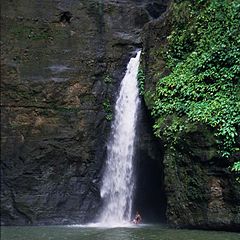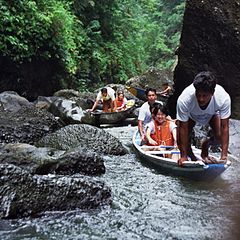- Pagsanjan Falls
-
Pagsanjan Falls 
Inside the cave behind the waterfallLocation Laguna (province), Philippines Coordinates 14°15′45.32″N 121°29′59.86″E / 14.2625889°N 121.4999611°ECoordinates: 14°15′45.32″N 121°29′59.86″E / 14.2625889°N 121.4999611°E Type Plunge Number of drops 2 (one is hidden) Longest drop 120 metres (390 ft) Watercourse Pagsanjan River Pagsanjan Falls (indigenous name: Magdapio Falls) are one of the most famous waterfalls in the Philippines. Located in the province of Laguna, the falls are one of the major tourist attractions in the region. The falls are reached by a river trip on dugout canoe known locally as shooting the rapids, originating from the municipality of Pagsanjan.[1][2] The town itself dates from early Spanish times and lies at the confluence of two rivers, the Balanac and the Bumbungan.
Contents
Location
The waterfalls are actually located within the boundaries of Cavinti, Laguna but access by a boat originates from the town of Pagsanjan. A move by the ruling body of the town of Cavinti was submitted to the Sangguniang Bayan (legislature of municipalities in the Philippines) on February 10, 2009 proposing the renaming of the falls to Cavinti Falls.[3]
National Park
The falls and gorge were declared as National Park with Proc. 392 on March 29, 1939 and Proc. 1551 on March 31, 1976. The Pagsanjan Gorge National Park covers an area of 152.64 hectares (377.2 acres).[4]
Legend
According to history, the Pagsanjan Falls is rich in legendary lore. Long, long ago, recounts one legend, there were no falls. There were only the foliaged highlands, the twin rivers, called Bumbungan and Balanac, and the alluvial delta (where the town of Pagsanjan now nestles). On the eastern bank of the Bumbungan River lived two old brothers named Balubad and Magdapio. For many years, the two brothers enjoyed a rustic life of peace and happiness. But one day calamity struck. A terrible drought brought ruin and death. No rains came for successive months. The soil became dry as tinder. The blooming flowers and food plants withered and died. The birds, deer, wild hogs, monkeys, and other animals disappeared. The rivers, creeks, and mineral springs dried up. Not a single drop of life-giving rain fell from heaven.
Balubad and Magdapio suffered immensely. Day and night, they prayed for rain, but the gods did not heed their prayers. The older and weaker of the two brothers, Balubad, died of thirst. Magdapio, with a sorrowing heart, buried him on the slope of the mountain overlooking the river delta. This mountain is now called Balubad.
Left alone in a waterless world, Magdapio agonizingly trekked to the upper region of the arid riverbed. He reached the high rocky cliffs, after an arduous journey. To his utter disappointment, he found no water.
"Ye gods!" he sobbed bitterly, "Where is the water?" In despair, he angrily hurled down his big cane among the rocks.
Suddenly, a spring bubbled on the spot where the cane fell. Rapidly it grew bigger. The fresh waters roared down the canyon walls, soon becoming a booming waterfall. Amazed at the miracle, Magdapio fell on his knees and thanked the gods. He drank the cool water until he felt new energy surging in his blood. Thus emerged the falls of Pagsanjan.
See also
- List of waterfalls in the Philippines
- Pagsanjan, Laguna
- Philippines
- Pagsanjan Falls stamp error
External links
References
- ^ Peters, Jens (2005). "Philippines Travel Guide, 2nd edition", p.255-256. Jens Peters Publications, Germany.
- ^ De Villa, Jill Gale (1988). "Philippine Vacations and Explorations", p.59. Devcon I.P. Inc., Manila.
- ^ Lubugin, Frederick R. (2010-02-11). "Advocacy Campaign to rename Pagsanjan Falls to Pagsanjan Falls". Cavinti Official Website. Retrieved on 2011-02-16.
- ^ "Establishing and Managing Protected Areas - List of Initial Components". Protected Areas and Wildlife Bureaus. Retrieved on 2011-02-18.
Categories:- Waterfalls of the Philippines
- National parks of the Philippines
Wikimedia Foundation. 2010.


